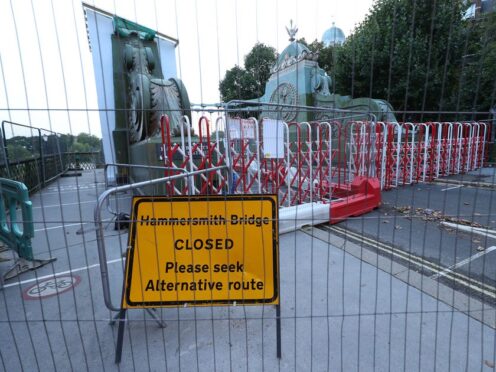
One in every 25 bridges on Britain’s local roads are unable to carry the heaviest vehicles, new figures show.
Motoring research charity the RAC Foundation, which carried out the analysis, expressed concerns over the impact of severe weather and a shortage of engineering skills.
It found that local authorities identified 2,928 of the 73,208 bridges they are responsible for as being substandard at the end of last year.
This means they are too weak to be used by 44-tonne lorries, the heaviest vehicles allowed on public roads.
Many of these bridges are subject to weight restrictions, while others are under programmes of increased monitoring or even managed decline.
Devon is the local authority area with the most substandard bridges at 222, followed by Essex (148), Somerset (128), Suffolk (119) and Cheshire East (108).
Some are substandard because they were built to earlier design standards, while others have deteriorated through age and use.
Cracks in the pedestals of Hammersmith Bridge, west London, have led to motor vehicles being banned from using the 136-year-old cast iron structure since April 2019.
The proportion of bridges that are substandard has fallen from 4.4% a year ago to 4.0%.
Between them, local authorities said they would ideally want to bring 1,955 of their substandard bridges back up to full carrying capacity.
But budget constraints mean they anticipate that only 292 will have the necessary work carried out on them within the next five years.
The bridge maintenance work backlog across Britain is an estimated £6.8 billion.
The analysis was based on data provided by 201 councils in response to freedom of information requests, and was carried out in partnership with Adept, a group representing local authority bosses responsible for transport and other sectors.
Bridges included in the research range from major structures across estuaries to stretches of road at least 5ft (1.5m) in length spanning culverts carrying water under carriageways.
RAC Foundation director Steve Gooding said: “This data should not be used as a stick to beat highway authorities with.
“While on the one hand it looks like councils are holding their own in keeping their road networks functioning, with every year which passes we are seeing the challenge of maintaining climate resilience increase in the face of more extreme weather.
“It is unrealistic to think that there will be vastly more money added to the road and bridge maintenance pot but there are measures that could help stem the tide of decline, such as a real drive to recruit, train and retain engineers with the right expertise, plus the delivery of a fresh five-year funding settlement for local roads, which would at least allow highway teams to plan ahead.
“Ideally, faced with the long-term challenge of constrained funding and deteriorating weather, we desperately need innovative engineering solutions to provide cheaper, more resilient repairs.
“The real danger lies in the change in climate – more temperature extremes and more wind, rain, snow and ice put are putting an ever-greater strain on the foundations of our roads and the structures that carry them.”
Keith Harwood, who chairs the national bridges group of Adept, an organisation representing local authority bosses responsible for transport and other sectors, said: “Our nation’s highway infrastructure represents centuries of investment, serving as the backbone of our economy and communities.
“However, as our bridges age and face mounting pressures from increased traffic and the impacts of climate change, maintaining their resilience becomes increasingly critical.”
Darren Rodwell, transport spokesman for the Local Government Association, said: “Councils want to do all they can to maintain local highways infrastructure for residents and visitors.
“Despite their best efforts, funding constraints limit the amount that councils can do in fulfilling these duties.
“Long-term, consistent funding for all councils would provide certainty for them to properly plan ahead and focus on preventative measures, to make all of our local highways infrastructure more resilient.”

Enjoy the convenience of having The Sunday Post delivered as a digital ePaper straight to your smartphone, tablet or computer.
Subscribe for only £5.49 a month and enjoy all the benefits of the printed paper as a digital replica.
Subscribe